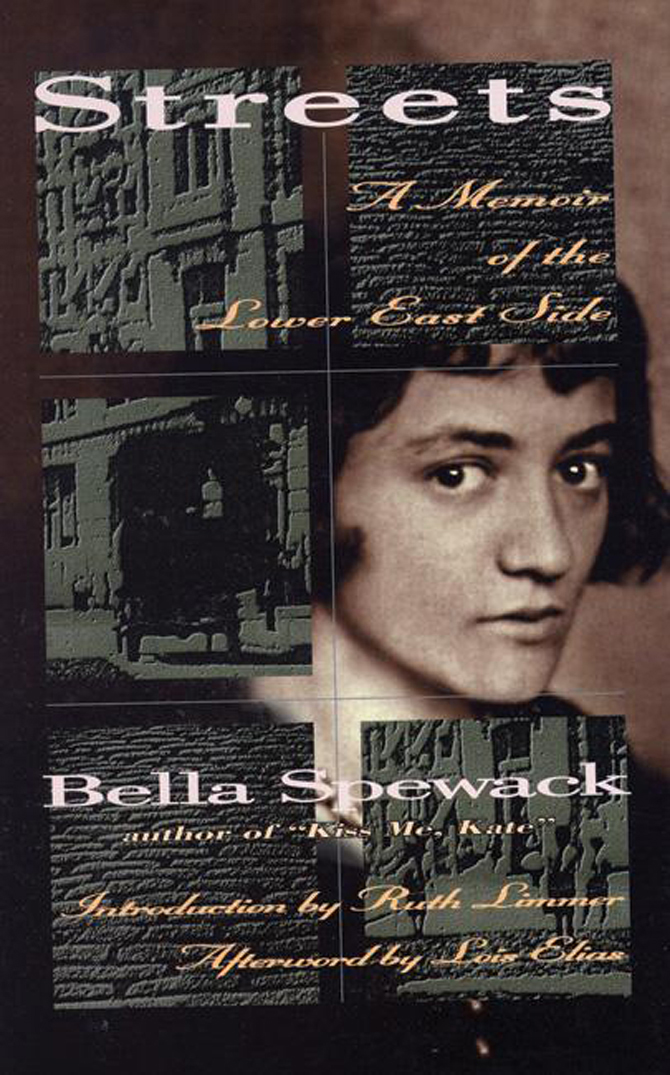
Samuel and Bella Spewack Papers, Rare Book and Manuscript Library, Columbia University
Bella Spewack, circa 1921

1995 by Lois and Arthur Elias
Introduction 1995 by Ruth Limmer
Afterword 1995 by Lois Raeder Elias
Published 1995 by The Feminist Press at The City University of New York
The Graduate Center
365 Fifth Avenue
New York, NY 10016
All rights reserved.
First paperback edition 1996
Streets was first serialized in Tenement Times, a publication of the Lower East Side
Tenement Museum.
Library of Congress Cataloging-in-Publication Data:
Spewack, Bella Cohen, 18991990
Streets: a memoir of the Lower East Side / Bella Spewack; introduction by Ruth
Limmer; afterword by Lois Elias.
p. cm.
ISBN-13: 978-193693-212-2
1. Spewack, Bella Cohen, 1899-1990Homes and hauntsNew York (N.Y.) 2. Lower East Side (New York, N.Y.)Social life and customs. 3. Women dramatists, American20th centuryBiography. 4. Spewack, Bella Cohen, 1899-1990Childhood and youth. 5. JewsNew York (N.Y.)Social life and customs. I. Title.
PS3537.P54Z475 1995
812.52dc20
[B]
95-13874
CIP
This publication is made possible, in part, by public funds from the New York State Council on the Arts and the National Endowment for the Arts, and by a grant from the John D. and Catherine T. MacArthur Foundation. The Feminist Press is also grateful to Joanne Markell and Genevieve Vaughan for their generosity.
Steven H. Scheuer, in memory of his mother, and in celebration of her life and the 100th anniversary of her birth, is pleased to announce a substantial gift to The Feminist Press to endow the Helen Rose Scheuer Jewish Womens Series. Streets is the first named book in this series.
Cover photo: Bella Cohen Spewack, 1921. Courtesy of the Samuel and Bella Spewack Papers, Rare Book and Manuscript Library, Butler Library, Columbia University.
For street scene photos, see pp. xxxvxxxvii.
Interior design: Tina R. Malaney
Cover design: Ascienzo Design
Third reprint.
CONTENTS
Table of Contents
Guide

T he Feminist Press is grateful to Arthur Elias, the executor of the Bella Spewack Estate, and Lois Elias for bringing the manuscript of Streets to our attention, and to Ruth Limmer, who suggested our name to the Eliases. Ruth Limmer also believed in the project enough to see that it was serialized (199495) in the Tenement Times, a publication she edits for the Lower East Side Tenement Museum. She did the initial copy-editing expertly and with utmost care for the authors own style; supplied explanatory footnotes where needed; and assisted us in obtaining reproducible prints of seven of the photographs included here.
We also thank the Rare Book and Manuscript Library at Columbia University (the home of the Sam and Bella Spewack Papers) and the New York Public Library photo archives for their cooperation on this project.
In the memoir, those footnotes followed by R.L. were supplied by Ruth Limmer; those followed by B.S. appeared in the original manuscript.

B ella Spewack was twenty-three years old, a tiny womanin 1922 she would still have been called a girlnewly married and leaping with ambition. That her formal education had ended when she was graduated from Washington Irving High School in New York City made no matter. She had worked as a reporter, and she had already written and published a number of short stories. Now she and her husband, Sam, were foreign correspondents alternating between Berlin and Moscow. Now she would tackle the kind of extended narrative expected of a real writernone of this journalistic junk as she called it. She would attempt a memoir.
She would... pry open my coffin of memories and describe her early life, beginning with her arrival on the Lower East Side in 1902 or 1903.
Her mother was an abandoned wife, at least thats how Bella described her. Whatever her true status, single parenthood could not have been comfortable in Transylvania. With Bella toddling alongside, the teen-aged Fanny Cohen left her family behind in the backwaters of the Austro-Hungarian Empire and came to America.
Tiny Bella would become famous. As a playwright and scriptwriter with her husband-collaborator Sam, she would hobnob with great artists and composers, would be the toast of Hollywood and Broadway. But first, Bella would have to learn English, endure the degradations of both poverty and charity, get an education, suffer loss of a beloved brother, and fight her way out of the Lower East Side.
Only learning English was easy.
Streets is the story of the hardships.
Streets is also the story Bella Spewack never submitted for publication. During her later years, she often talked about publishing the manuscript, but it was only talk. Did she fear that a commercial publisher would reject it? Did she want to maintain control over what the flap copy would say and how the book would be advertised? Her executor, the painter Arthur Elias, and his wife, media specialist Lois Elias, do not know to this day. But if it was fear of rejection, it was one of the very few times the adult Bella Spewack experienced fear.
As a professional, Bella Spewack understood that a writer had to put herself on the line. Sink or swim, when the curtain came down you either had a hit or you hadnt. The next day, one way or the other, you went back to the typewriter and began anew.
Because beyond being devastatingly witty, Bella was tough. She never pulled her punches, not in Streets, not in life. She spared neither herself nor anyone else. And she was painfully direct. When, as a child, a little boy pinched her, she did not go sobbing to the teacher. She kicked him, hard. How else would she have climbed out of those streets?
She began the ascent early. As her memoir details, she entertained others, she read, she explored, she examined her surroundings ruthlessly, and she began to write. Her first published piece appeared in the Courier of P.S. 147. In it, she took a dim view of the little suffragettes voting in the school election.
Then or earlier, she committed herself to becoming a writer. She was editor of her high school magazine. Once graduated, she sought jobs with newspapers. Bella could have attended college had she really wanted to. Hunter College was tuition-free and textbooks were supplied. Many girls combined work with higher education, even those like Bella who were partially responsible for the support of their families. But in fact high school was more education than most of Bellas generation received. Its full if rigid curriculum, combined with her passion for reading, provided the intellectual underpinnings of a career as a full-time professional writer. Her ambition and her desire to prove herself provided the rest.
But it was not easy to find newspaper employment. With some bitterness, she would tell about the managing editor at United Press International (UPI) who responded to her request for a job with a pat on the head and the comment, We dont hire girls.
















